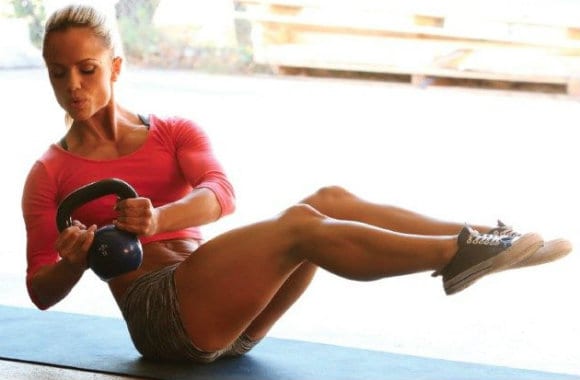The folding or book crunch exercise, also known as a V-up or Jackknife Sit-Up is a good exercise for the abdomen.
High abs, low abs? As we have already said over and over again, this distinction makes no sense: the muscle we are going to train is the rectus abdominis, a single large muscle that originates from the ribs and inserts itself into the pubis.
Il crunch a libretto, it is called in this way because the exercise consists in "closing" like a book by approaching the torso and the straight legs at the same time starting from a lying position.
The execution involves the athlete lying on his back on a mat with his legs together and stretched and his arms parallel stretched over his head, all limbs resting on the ground.
The starting position requires that both the legs and the arms are raised by about ten centimeters and they will no longer rest on the floor for the whole series.

At this point the athlete will raise the legs until they reach 90 ° with respect to the ground and at the same time will do the same thing with the arms, lifting the torso and detaching the upper back in search of a "book closure". At this stage it will be important to keep the gaze towards the feet and exhale completely.
Those who want to intensify the exercise can maintain the isometric contraction for 1 or 2 seconds in this position.
Then with a slow and controlled movement you return to the starting position while inhaling.
Errors to avoid
The back should not come completely off the floor, the lumbar part must always remain supported. The movement must be slow and controlled, you must not throw yourself out with your arms. The work must focus on the abdominals, without involving too much the other muscles involved in the movement. Legs and arms should not be placed on the ground during the exercise, so as to maintain constant tension on the abdominals.
Variants of the Book Crunch
Folding closures on flat bench
The athlete sits on the edge of the bench and places his hands behind him, resting on the bench itself so as to push the back up, while the legs are stretched and straight forward. The movement consists in bringing the knees towards the torso keeping the back still, and then returning to the starting position. The reduction of the support base and the height from the ground inevitably call into question the ability to balance and, consequently, a strong abdominal and lumbar muscle activation also as stabilizers of the body in conditions of imbalance.

The support of the hands must serve only to avoid losing balance during the opening phase of the movement and not to exert a push with the shoulders and arms.
Folding closures with swiss ball
the athlete lies down on his back on the ground holding the ball in his hands and legs raised from the floor; he will perform the movement of the book crunch and when he reaches the maximum closing position, he will move the ball between his feet and return to the starting position, then he will perform the same movement by returning the ball in his hands.
Book closures with medicine ball
the athlete lies on his back on the ground with his legs straight and his feet together, holding a medicine ball with both hands above the head; at the same time he will lift his legs and torso off the floor, bringing his arms forward until the ball touches his ankles, reversing the movement to return to the starting position. Using a medicine ball as an overload will make the exercise heavier.
Conclusions
Il crunch booklet is a good exercise to train the abdomen, much more difficult and tiring than normal crunches. So I recommend getting there step by step starting with normal crunches and reverse crunches and I do not recommend offering it to beginners. The first few times you can do it in its simpler version than to keep the knees bent and finally get to do the real book closings and also use an overload such as a disk or a medicine ball.
Like all sit-ups, it tensions the back and therefore should not be performed in case of problems in the lumbar region.


























